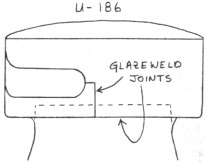Porcelain Insulator News
by Elton Gish, NIA #41
Reprinted from "INSULATORS - Crown Jewels of the Wire", July 1984, page 24
I agreed to be the new clearing
house for American Porcelain and Editor for this column because I wanted to see
more frequent informative columns and to hopefully improve the interest in
collecting porcelain insulators. I cannot do it alone! I need your help to
provide interesting and newsworthy articles that all of us can use to improve
our knowledge of the hobby. I will look forward to your questions, comments,
contributions and suggestions.
Dear Elton:
I bought an unusual porcelain
mid-span transposition insulator at the Rochester Show (refer to sketch below).
The fellow I got it from had found it at a flea market. It was in the original
box with a packing slip that had the following information:
 |
3G1100-104.3
Item 1-13
Insulator Transposition
1 Each
32093-P-55-59 (31)
Gar-Let Mfg. Co. , Scranton,
Pa
Date Pkd. 12/55
Method 111. |
It is unmarked with red-brown glaze. Dimensions
are 6 inches long, 5 inches wide, and one inch thick, and it has five holes
through it.
Do you have any idea how these were used? If these were ever used,
it would involve much cutting, splicing and cursing on the part of the lineman
to install it.
On an abandoned railroad signal/communication line in my area, I
found some H.K. Porters on an electrical circuit for the semaphores. They were
clear and had red paint applied to the inside of the skirt and pinhole. Were
these used as market insulators? I also found an H.K. Porter with a one-half
inch pinhole.
At Rochester I also saw a U-207 transposition with a cream colored
glaze and black treated wire grooves. What was the purpose of the treatment?
William Ogden, NIA #1857
- - - - - - - - - - -

Dear William:
We have no info on the block
transposition insulator, how it was used, or on Gar-Let Mfg. Co. I agree with
you that the design is impractical for use on telephone pole lines, and my
crystal ball says this thing is used in some way for radio antenna transmission
lines.
It sounds logical that the reddened H. K. Porter insulators are meant for
line coding, but not if all the ones in use there were treated that way. In so
many cases of oddball line configuration and equipment usage, you'll never find
out the reason they did things certain ways unless you can get back to the
people who did it and ask them. Trying to use horse sense or any form of logic
doesn't have a very high batting average for getting correct answers!
The U-207
transposition with black-treated wire grooves sounds highly unusual and must
have been a very pretty and desirable specimen. If this did in fact have
purposeful radio-treated wire grooves and not just darkening in the recessed
areas from a firing problem (as sometimes happened), I can think of only one
logical reason for it. That is, it could have been made expressly as a
"break insulator" for high-voltage, series street light circuits --
even though most of those circuits generally have maximum voltages below that
where radio interference problems occur.
Elton
Dear Elton:
I have a white
Hewlett insulator that is 6-1/2 inches in diameter. It is marked as follows: PAT
SEPT 15 14. Do you have any information on these being found in white?
Richard Wiesman, NIA #3029
- - - - - - - - - - -
Dear Richard:
Many thanks for your report of a white Hewlett.
Maybe someone else has seen one of these, but I've never heard of a white
Hewlett of any type, size or style. Of all the line insulators other than pin
types, the O-B pig liver link strain insulator and the various Hewlett dead-end
and suspension insulators are probably the most collectible ones. Certainly this
white one would be at the top of that class.
Elton

Dear Elton:
NIPSCO is
rebuilding a line near my home, and they were kind enough to allow me to inspect
the equipment that they were using. The insulators are twelve skirt clamp-top
line posts mounted both vertically and horizontally. They are skyglaze and rated
for 69 KV. The new O-B marking on each unit is a dark blue underglaze located on
the top skirt. This is the first I have seen of the new logo.
Robert Winkler
Michigan City, Indiana
- - - - - - - - - -
Dear Robert:
They've been making the newer logo for a
number of years on, in their words, "new items" as they come up. Use
of the logo has been reported on a number of items, including the cast iron
parts of certain line insulator types. It is thus not surprising for it to turn
up on the porcelain parts of line posts.
But, also in their words of some time
ago, they have no plans for use of the new logo marking on low voltage pin type
insulators. We'll continue to assume that is the case until one actually turns
up someday, if ever.
Elton

It can now be confirmed that the U-186 is
glazewelded. I have a specimen that has a thin glaze with open bubbles in the
glaze over the glazeweld joints. The head was made in two parts and glazewelded
to the body.
| 